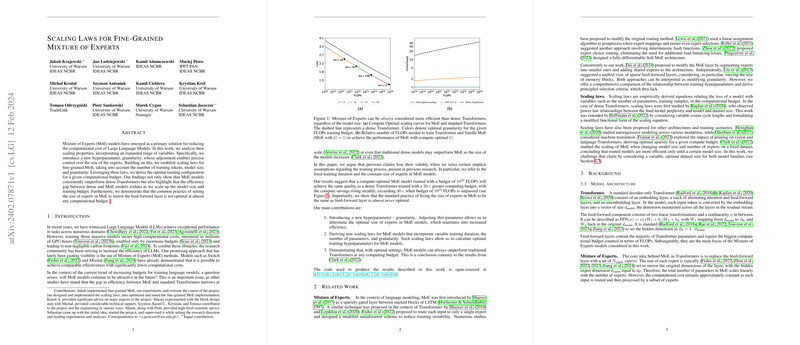Unveiling the Efficiency of Fine-Grained Mixture of Experts in LLMs
Introduction to Mixture of Experts and Model Efficiency
The computational demands of training LLMs have escalated significantly, prompting a search for more efficient architectures. Mixture of Experts (MoE) models have emerged as a promising solution for reducing these demands. Our paper explores the scaling laws of fine-grained MoE by introducing granularity as a key hyperparameter to control the size of experts, thereby fine-tuning the computational efficiency and model performance.
Granularity: A New Perspective on MoE Configuration
The core contribution of this research lies in the introduction of the granularity parameter, fundamentally altering the conventional MoE configuration. Traditional MoE models typically equate the size of experts to that of the feed-forward layer within the model. We propose a variable approach, where granularity enables the determination of the optimal size of experts, thus opening avenues for computational savings without compromising performance.
Derivation of Scaling Laws Incorporating Granularity
Our analytical work leads to the derivation of novel scaling laws that take into account not only the model size and number of training tokens but also the introduced granularity parameter. This approach allows for a meticulous calculation of optimal training configurations across varying computational budgets. Empirically, we demonstrate that MoE models, when optimally configured, invariably surpass dense Transformers in terms of computational efficiency, particularly as the scale of model size and training budget increases.
Empirical Validation and Practical Implications
The practical aspects of our research are grounded in extensive experimental work, where we assess models ranging from 129M to 3.7B parameters. The granularity parameter, spanning logarithmically spaced values, reveals its crucial role in achieving optimal training efficiency. The implications are clear: adopting fine-grained MoE models not only leads to notable computational savings but also enhances the model's performance across a variety of configurations and computational budgets.
Future Horizons in MoE Model Optimization
Looking forward, our work lays the groundwork for further exploration into the intricate balance between model efficiency and performance within the domain of LLMs. The concept of granularity, alongside the newly established scaling laws, provides a framework for ongoing and future research efforts aimed at refining the architecture and training processes of MoE models.
Concluding Remarks
Our investigation into fine-grained MoE models establishes a nuanced understanding of their scaling properties and offers a methodological approach to optimizing their configuration. The overarching goal is to pave the way for more resource-efficient LLMs without sacrificing their formidable capabilities. As the field of artificial intelligence evolves, the insights garnered from this paper beckon a recalibration of how we approach the computational challenges inherent in training large-scale models.
